Woodland Restoration
Historic Woodlands of the Midwest
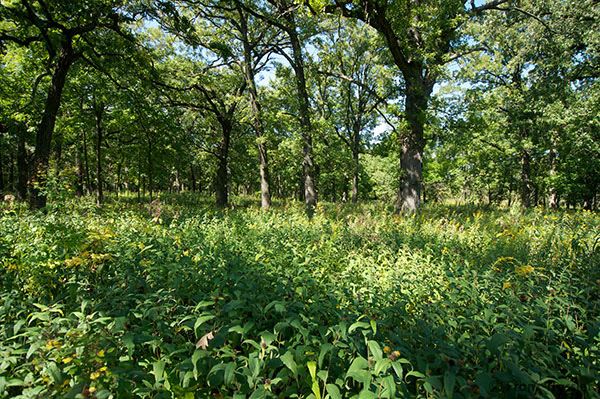
As the glaciers receded from our region over 12,000 years ago, Native Americans moved into the landscape, and began shaping it with fire. They used fire to promote the growth of food plants, to attract game species, for warfare and defense. Oak trees, are well adapted to fire with thick bark to insulate them from the heat, the ability to readily resprout if they are damaged and large acorns filled with starch that give young seedlings a rapid start in life.
During the in the Public Land Survey of our region in the 1830’s, up to 95% of all trees were oaks. In southern Wisconsin, woodlands covered about 40% of the landscape and savannas covered about 30% of the land. The open canopy of these habitats allowed plenty of sunlight to reach the ground so that a diversity of fire tolerant wildflowers, grasses and shrubs could thrive. These plants in turn supported a diverse array of wildlife including beneficial insects, songbirds, reptiles, amphibians and large game, deer, elk, bison, moose, bear and others thrived throughout the midwest. Native Americans found various plants for building materials, food and medicine in the landscape they sculpted with fire.
A Changing Landscape and Degrading Woodlands
 The first Euro-American settlers described midwestern woodlands as “open” and “park-like” with large stately oaks, and a widely spaced open canopy.
The first Euro-American settlers described midwestern woodlands as “open” and “park-like” with large stately oaks, and a widely spaced open canopy.
Some of these woodlands were logged and then converted to crop land. Those that remained slowly began to fill in with fire-intolerant, but shade tolerant tree species. Some farmers continued the practice of burning their woods and pastures to promote vigorous ground-layer growth for their grazing cattle. But in the latter half of the 20th century, fires were largely stamped out with the Smokey the Bear propaganda efforts during a time when the benefits of wildland fire were not well understood, and the risks were greatly feared.
Today, oak woodlands bear little resemblance to their 'natural' and healthy condition. Oak savannas are now a “globally imperiled” ecosystem with just .01% remaining of the original oak savanna in Wisconsin. In the woodlands that do remain, aggressive, fire-intolerant trees such as maple, box elder, walnut, ash, cherry, basswood and elm have begun filling in the canopy under, and in-between the oaks, leaving little light reaching the ground.
"... on the fertile Corn Belt soils, all of our oaks are headed for oblivion, except where ecological restoration or other intentional management protects them."
Stephen Packard
The Tallgrass Restoration Handbook
Oak seedlings aren't getting enough light to germinate and survive. Young oak trees are becoming a very rare plant on the landscape, only occasionally found on the edges of woodlands. Woodlands once had abundant grasses and wildflowers that bloomed all through the spring, summer and fall. Now most woodland wildflowers are not getting enough light to flower and reproduce.
These unbalanced ecosystems are ripe for invasion by non-native species. Eurasian plants such as buckthorn, honeysuckle and garlic mustard, are well adapted to shaded and disturbed woodlands. Their explosive growth further impacts the woodland community.
Our oak-hickory woodlands are now nearing a breaking point. Without new oak seedling 'recruits', once the old trees die, the oak woodland will be no more.
Issues Affecting Our Woodlands and How to Fix Them
Invasive Brush
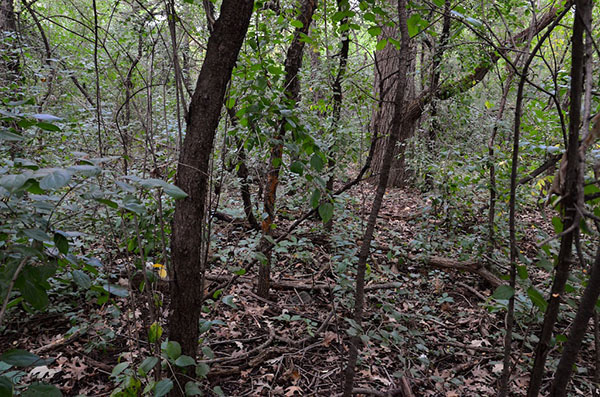 There are many species of shrubs that invade our woodlands, but the most common are common buckthorn and bush honeysuckle. Both of these species compete for sunlight, water and other resources. Left unchecked, in time either of these two shrub species can wipe out nearly all other plant life in a woodland.
There are many species of shrubs that invade our woodlands, but the most common are common buckthorn and bush honeysuckle. Both of these species compete for sunlight, water and other resources. Left unchecked, in time either of these two shrub species can wipe out nearly all other plant life in a woodland.
Common buckthorn not only shades out native plants, it also releases a chemical called emodin into the soil that can weaken and kill other plants. The berries have a poor nutritional quality, and furthermore, they have a laxative in them which can lead to dehydration and malnutrition in song birds.
Did you know that buckthorn is the overwintering host to soybean aphids, which cause major crop damage throughout the midwest?
A lot of research has come out in the past few years explaining how harmful bush honeysuckle can be. Here’s a blog post with more detail. In brief, honeysuckle is directly harmful to birds in that the berries are not nutritious, while the red coloring can discolor plumage. Meanwhile the branches make poor nesting habitat and the shrubs effectively destroy amphibian habitat too. Honeysuckle shrub infestations has also show to be correlated with dramatically increased tick populations
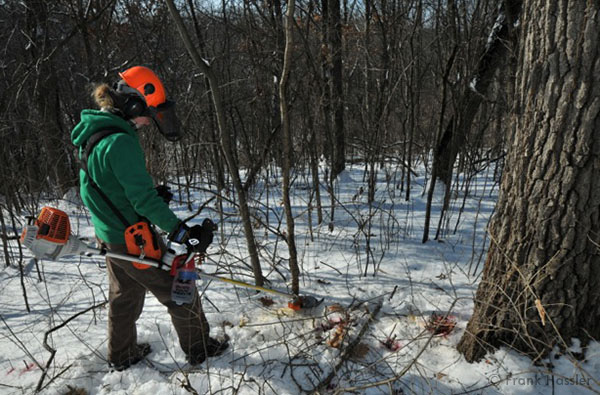 There are other invasive shrubs too: Japanese barberry, autumn olive, multiflora rose, Oriental bittersweet, and white mulberry are just a few of the invasive species we can identify and control in your woods. Because of fire suppression, native shrub species like grey dogwood, sumac and prickly ash can also get out of control at times and may also need to be removed.
There are other invasive shrubs too: Japanese barberry, autumn olive, multiflora rose, Oriental bittersweet, and white mulberry are just a few of the invasive species we can identify and control in your woods. Because of fire suppression, native shrub species like grey dogwood, sumac and prickly ash can also get out of control at times and may also need to be removed.
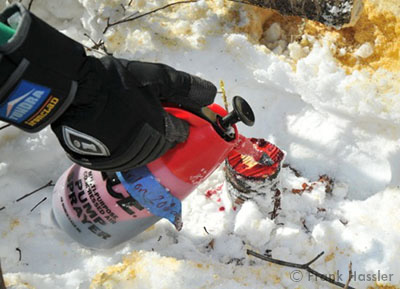 The Good Oak team has worked hard to develop the skills and curate a toolset that allows us to be extremely effective at clearing invasive brush. We don’t generally like to boast, but in this case we feel like we’re the most expert and most efficient team in the business. We do most of our brush clearing in the winter in order to get the job done in the most ecologically sensitive manner.
The Good Oak team has worked hard to develop the skills and curate a toolset that allows us to be extremely effective at clearing invasive brush. We don’t generally like to boast, but in this case we feel like we’re the most expert and most efficient team in the business. We do most of our brush clearing in the winter in order to get the job done in the most ecologically sensitive manner.
Can't See the Woodland for the Trees
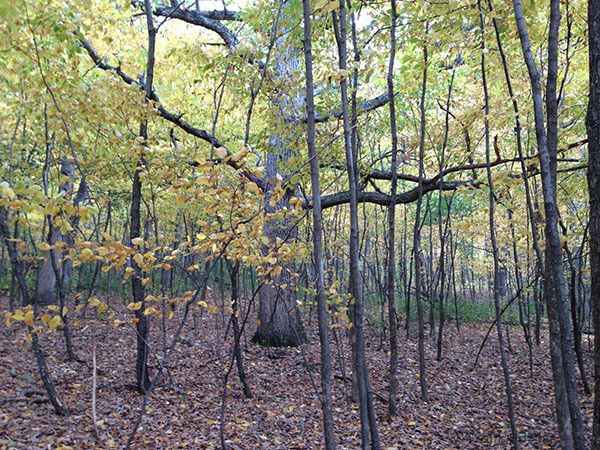 As strange as it may at-first sound, our woodlands have too many trees. Its easy to see if you know what to look for: Most woods have relatively few large, old oaks, and a large number of small skinny trees, none of which are oaks.
As strange as it may at-first sound, our woodlands have too many trees. Its easy to see if you know what to look for: Most woods have relatively few large, old oaks, and a large number of small skinny trees, none of which are oaks.
The two primary benchmarks we use to asses the effectiveness of woodland restoration are: 1) to stimulate germination and growth of oak seeding and 2) to establish a diverse mix of ground-layer plants that will provide resources for wildlife; flowers with nectar, fruits, seed, leaves, stems and roots of various sizes and shapes to provide food and shelter for creatures ranging from bees and butterflies to turkeys and deer.
In order to achieve this goal, we must have more light reaching the ground to provide the energy to fuel the tree and wildflower growth. Most woodlands have tree canopies shading out 90% (or more) of the blue sky. A healthy woodland has a canopy cover of 50-70%, letting in much more light which drives the whole ecosystem. A more open woodland has better airflow too, which means fewer mosquitoes, and better distribution of wind-borne wildflower seeds.
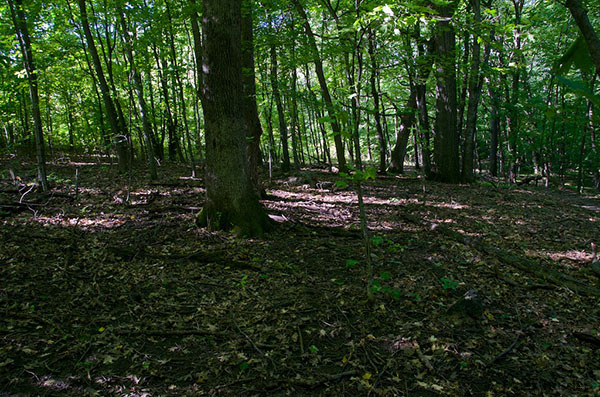 Choosing which trees to remove among a mix of native trees takes a deep knowledge of woodland ecology. We always leave all the oaks and hickory trees, but most other tree species can be target. We start with trees that are close to oaks, directly competing with them for light and water. Then we remove trees that don't look healthy or are small. Some weedier species like box elder, we remove entirely. We generally leave a small selection each species of tree in order to maintain a representative diversity of the site. But the overall goal is to return the woodland to a state where oaks are once again the dominant tree.
Choosing which trees to remove among a mix of native trees takes a deep knowledge of woodland ecology. We always leave all the oaks and hickory trees, but most other tree species can be target. We start with trees that are close to oaks, directly competing with them for light and water. Then we remove trees that don't look healthy or are small. Some weedier species like box elder, we remove entirely. We generally leave a small selection each species of tree in order to maintain a representative diversity of the site. But the overall goal is to return the woodland to a state where oaks are once again the dominant tree.
The logs that result from this tree thinning can be used as firewood or we can burn them in our brush fire. Larger trees, cherries and walnuts in particular, may have some commercial value. We can put you in touch with a local logging or woodworking company that will pay you to take these trees as part of the restoration process.
Removing invasive brush and thinning weedy trees doesn't just improve the aesthetics of woodlands. It increases the ecological health, allowing oak seedlings and wildflowers to grow. Hunters note that clearing brush and trees improves sight-line while re-establishing ground-layer vegetation attracts more game.
Reintroducing Prescribed Fire
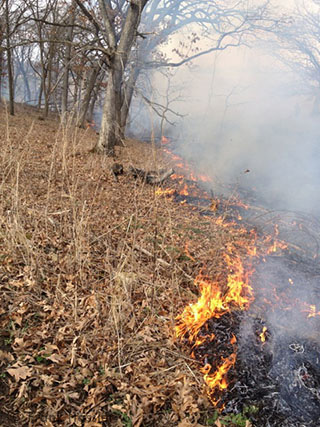 Fire has a number of effects in an oak woodland, but can generally be considered a rejuvenating and regulating force.
Fire has a number of effects in an oak woodland, but can generally be considered a rejuvenating and regulating force.
Oak trees for one, are both fire resistant, their thick bark insulates them from the low-intensity fires that occur in woodlands. Other thin-barked trees like maples, basswood, elm and others are less fire resistant. And though all deciduous trees will resprout after a fire, few have the massive root system that really allows them to thrive after particularly intense fires.
Prescribed burns help suppress invasive brush by killing seedlings and top-killing older plants. Similarly, most invasive weeds like garlic mustard are not well adapted to fire, but native wildflowers are adapted to thrive after a fire.
Fires recycle nutrients from fallen leaves and branches back into the soil. This helps keep the soil rich and futile, and the soil biotic community thriving. This also allows sunlight to reach the ground encouraging germination of wildflowers and oaks seedlings alike.
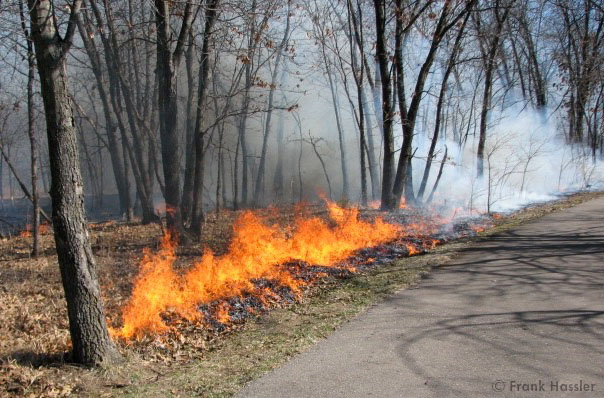 Fire is, of course, a force of nature which can be dangerous if care is not taken unleashing it. Good Oaks team has the experience training and equipment to conduct a prescribed burn in your woodland safely and efficiently. Our President Frank Hassler has been conducting prescribed burns for nearly 20 years and the entire crew has gone through nationally-certified wildland fire training. We will prepare your woods for a burn so as to carefully contain the fire where we want it. The burn will be conducted on a day with just the right weather, dry enough for the leaves to burn, but not too dry or windy so that the fire escapes or damages trees. Prescribed burning is both a science and an art, a practice we are quite adept at. For more information, see our Prescribed Fire page.
Fire is, of course, a force of nature which can be dangerous if care is not taken unleashing it. Good Oaks team has the experience training and equipment to conduct a prescribed burn in your woodland safely and efficiently. Our President Frank Hassler has been conducting prescribed burns for nearly 20 years and the entire crew has gone through nationally-certified wildland fire training. We will prepare your woods for a burn so as to carefully contain the fire where we want it. The burn will be conducted on a day with just the right weather, dry enough for the leaves to burn, but not too dry or windy so that the fire escapes or damages trees. Prescribed burning is both a science and an art, a practice we are quite adept at. For more information, see our Prescribed Fire page.
Garlic Mustard and Its Associates
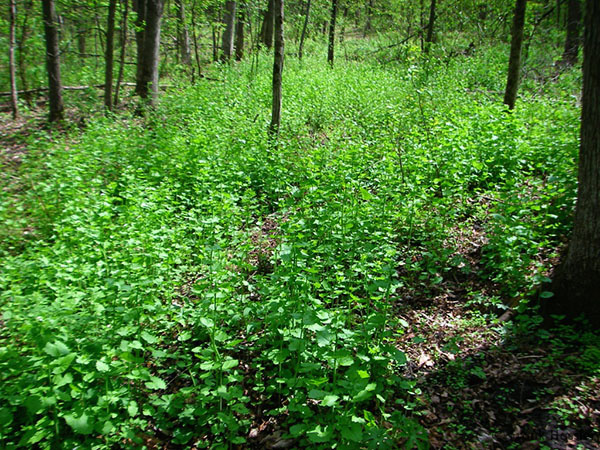 Many people are familiar with garlic mustard. This biennial weed spreads aggressively our woodlands today are disturbed and too shady; the deck is stacked in their favor! People are less familiar with a few other invasive biennials weeds, namely dames rocket, Japanese hedge parsley and motherwort. These species are similarly invasive, and we treat them all the same.
Many people are familiar with garlic mustard. This biennial weed spreads aggressively our woodlands today are disturbed and too shady; the deck is stacked in their favor! People are less familiar with a few other invasive biennials weeds, namely dames rocket, Japanese hedge parsley and motherwort. These species are similarly invasive, and we treat them all the same.
People get overwhelmed quickly when they try to hand-pull garlic mustard. Though satisfying, its hard work! It can also cause a lot of soil disturbance, which can perpetuate your weed issues and lead to erosion. We feel that pulling garlic mustard and their kin should be the last step in the control process, not the first.
We need to start by stacking the deck in our favor. Removing invasive brush and excessive weedy trees allows more light to reach the ground so that naive plants, which are adapted to more light, can grow more rapidly and compete head-to-head with the garlic mustard. Brush removal also makes it easier to move around in the woods and get work done.
 Prescribed fire can kill young garlic mustard seedlings and even weaker adult plants. Meanwhile it will invigorate native plants and promote germination, again giving the garlic mustard some stiff competition for resources.
Prescribed fire can kill young garlic mustard seedlings and even weaker adult plants. Meanwhile it will invigorate native plants and promote germination, again giving the garlic mustard some stiff competition for resources.
Then we can really begin to make progress directly manage garlic mustard. Herbicide is an effective and efficient tool if used carefully. We start with very-early-spring targeted spot-herbicide applications. Garlic mustard stays green all winter, meaning we can apply herbicide to the plants on the first warm days in the spring. Ideally, this is before native plants sprout at all, leaving no chance for ‘collateral damage’. Careful applications later in the spring are much more efficient than pulling as well, herbicide is only effective into the beginning of the flowering period. After that, its time to pull or mow any that remain. If the job is done right, very garlic mustard few plants make it this far in the first place.
The goal is to prevent any garlic mustard from seeding every year. By doing so, you will see the population drop off dramatically in just a few years. We can help you eliminate garlic mustard from your woods by working both smarter, and harder.
Rambling Brambles
Most of our woodlands were used as pasture at some point in the 180 years since settlement. Some were grazed aggressively, down to bare dirt. Others less so. Grazing not only eliminates species of plants that the cattle find most palatable, it also favors those species which are least palatable, artificially increasing their numbers.
Such is the case with many thorny bramble species. Blackberries, raspberries, gooseberries and prickly ash are all native species of low, thorny shrubs that can become particularly over-abundant in woods that were once heavily grazed. In small numbers these shrubs provide resources for wildlife (and tasty treats for people too!), too many leaves little growing space for other plants and makes it hard to move around in the woods as well.
Good Oak's staff knows these plants well, and understand their proper place in the ecosystem. We can knock back these brambles with mowing, careful herbicide applications, or both. Returning fire can be returned to the system and help control them in the long-run.

Sticking Seeds
In late summer and fall, people find that they get covered in a variety of clingy seeds after a walk in the woods. The big, round, brown seeds, are Common burdock, an exotic weed that does well in disturbed areas. There are a variety of smaller clingy seeds including enchanter's nightshade, wood avens and the aptly named, stickseed. These plants are actually native, but are weedy survivors in disturbed sites.
We have the experience identify these stickers at every stage of growth. Mowing or careful herbicide application can help us keep them in check as necessary. But overall, a healthy woodland will have fewer of theses sticky-seeded plants, reintroducing a diverse mix of ground layer plants is probably the best way to control them in the long-run.
Where Have the Flowers Gone?
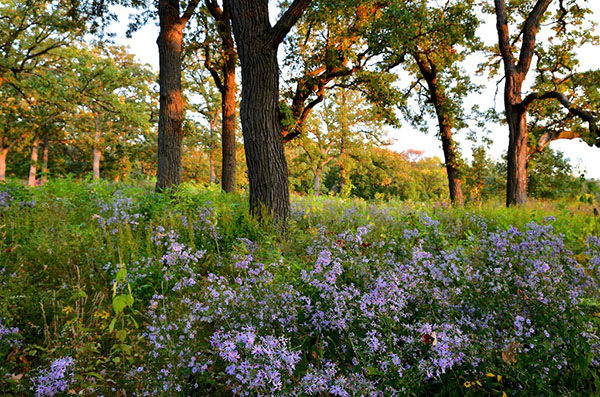 After all this work, sometimes the native wildflower return to the woods on their own, sometimes they do not. In most cases, at least some reintroduction of native woodland flowers and grasses is needed. If the oak trees are the pillars and ceiling of the woodland cathedral, then the ground layer plants are the foundation. A healthy woodland should have a ground layer covered in green, growing plants all summer, with a variety of wildflowers that bloom in series from April through October.
After all this work, sometimes the native wildflower return to the woods on their own, sometimes they do not. In most cases, at least some reintroduction of native woodland flowers and grasses is needed. If the oak trees are the pillars and ceiling of the woodland cathedral, then the ground layer plants are the foundation. A healthy woodland should have a ground layer covered in green, growing plants all summer, with a variety of wildflowers that bloom in series from April through October.
As the restoration process progresses, we can evaluate the pieces of the system that are present and those that are absent. Then we can develop a planting list, specific to your woodland, of those absent plants that we can reintroduce. Some species can be reintroduced by seed, an economical option. Others do better if planted as young live plants. We know which are which, and effective methods for giving these plants the best possible start growing in your woodland.
In Summary…
Our local woodlands have been greatly altered from their "natural" state. We have excluded fire from the woods, which was the primary regulator of the ecosystem before settlement. We have logged them, grazed them down to bare earth, introduced exotic plants, many of which are better adapted to these disturbed, shaded, altered environments then the indigenous plants are. We have altered our woodlands so much from their "natural" condition, its no wonder that direct management is necessary to prevent further decline.
 In order to save our woodlands and savannas we must actively mange them to restore them to a healthier condition. The alternative is that we lose these beautiful woodlands, with their dramatic open grown oaks, rich wildlife and beautiful wildflowers, forever. Woodlands need our help to get back on track. But if we do our job right, once they are healthy again they will need only a little help to take care of themselves.
In order to save our woodlands and savannas we must actively mange them to restore them to a healthier condition. The alternative is that we lose these beautiful woodlands, with their dramatic open grown oaks, rich wildlife and beautiful wildflowers, forever. Woodlands need our help to get back on track. But if we do our job right, once they are healthy again they will need only a little help to take care of themselves.
Gallery of Brush Clearing, Before-and-After Photos
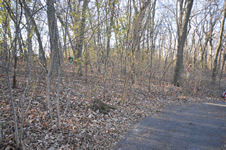
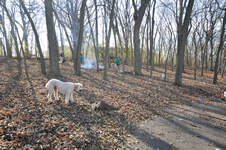
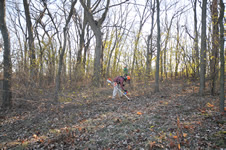
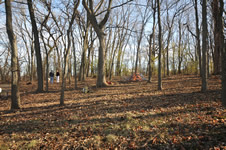 |
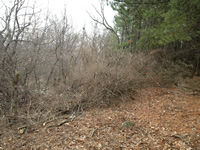
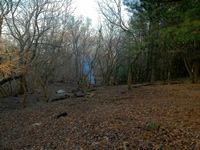
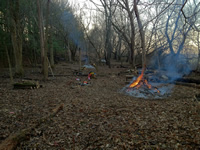 |
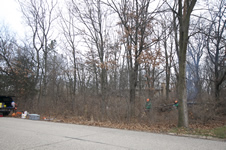
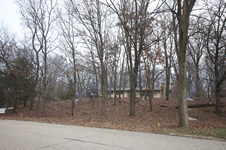 |
Brush clearing: Select a design thumbnail to view the expanded photo. |